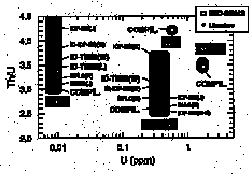
One promising improvement in multi-element analysis of geological samples is the use of a recently developed multi-ion counting (MIC) technique in spark source mass spectrometry (SSMS) (Jochum et al., 1994). MIC-SSMS combines the advantages of simple sample preparation (with no chemical treatment of samples) with modern on-line detection of elements using a detector array consisting of 20 separate small (1.8 mm wide) channeltrons. It is therefore one of the most powerful existing methods for mult-element analysis. Up to 20 trace elements are measured simultaneously in 10 min to 1h. This is an improvement of more than a factor of 20 compared to the conventional SSMS using photoplates for ion detection. The mass range can be switched rapidly by changing the magnetic field. Precision is about 1 - 2% for trace element concentrations > 0.1 ppm and about 4% for concentrations of about 0.01 ppm. Accuracy is similar to the attainable precision using multi-element isotope dilution (ID) for internal standardization. Detection limits vary between < 0.001 ppm for mono-isotopic and sensitive elements (e.g., Cs, Th, Pr, Ho) and about 0.02 ppm for poly-isotopic and insensitive elements (e.g., Ir, Pt). Sample consumption is very low (generally < 10 mg rock powder) and permits multi-element analysis where only small amounts are available, e.g. basalt glasses, minerals, inclusions and extraterrestrial samples.
In the initial experiments, we tested MIC-SSMS mainly for the analysis of Th, U, rare earth elements, Hf, Re, Os, Ir, Pt and Au of international geostandards (Jochum et al., 1994), oceanic basalts (Jochum et al., 1995) and stony
meteorites (Jochum and Seufert, 1995). Fig. 1 shows a comparison of the Th and U results for several reference materials with the compiled values by Govindaraju (1994) and other recently published data, mainly by ICP-MS and TIMS. Our results for the well-analyzed standards
BCR-1 and W-1 agree with the compiled values within 2%. BHVO-1 and especially BIR-1 have lower trace element contents than BCR-1 and W-1. The agreement for these samples with reference values is poorer; however, our values agree very well (better than 3%) with the high precision ID measurements using TIMS.
Govindaraju, K., Geostandards Newsletter 18, 1-158 (1994).
Jochum, K.P., Laue, H.-J., Seufert, H.M. & Hofmann, A.W., Fresenius J. Anal. Chem. 350, 642-644 (1994).
Jochum, K.P. & Hofmann, A.W., In Mauna Loa Revealed, Geophys. Monograph 92 (Rhodes, M., ed.) AGU, 307-314 (1995).
Jochum, K.P. & Seufert, H.M., Meteoritics 30, 525 (1995).
Fig. 1: Comparison of MIC-SSMS Th, U data for 4 geostandards with literature values.